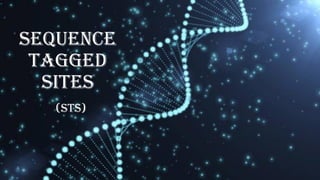Sequence Tagged Sites pdf.pdf
Dive into the fascinating world of genomics with our latest video! 🧬 In this exploration, we unravel the mysteries of Sequence Tagged Sites (STS) and their crucial role in understanding the intricate language of DNA. 🧬 What are STS, you ask? Join us as we break down the concept of Sequence Tagged Sites, which are unique landmarks along the DNA sequence that help researchers navigate the vast genomic landscape. Discover how STS play a pivotal role in gene mapping, genome sequencing, and unraveling the secrets encoded in our DNA. 🔬 Whether you're a student, a science enthusiast, or just curious about the wonders of genetics, this video is designed to make complex genomic concepts accessible and engaging. We'll explore the significance of STS in genetic research, discuss their applications in molecular biology, and showcase real-world examples of how STS are revolutionizing our understanding of the human genome. 🚀 Join us on this scientific journey as we delve into the world of Sequence Tagged Sites – from their discovery to their impact on modern genomic research. Get ready to unlock the mysteries of DNA, one sequence at a time! 👩🔬👨🔬 Don't forget to hit the like button, subscribe to our channel, and ring the notification bell to stay updated on our latest scientific explorations. Share this video with fellow enthusiasts and let's embark on a thrilling adventure into the heart of genomics together! #Genomics #DNA #ScienceExplained #SequenceTaggedSites #MolecularBiology #GeneticResearch #ScienceEducation #ExploreWithUs

Recommended
Recommended
More Related Content
Similar to Sequence Tagged Sites pdf.pdf
Similar to Sequence Tagged Sites pdf.pdf (20)
More from NetHelix
More from NetHelix (20)
Recently uploaded
Recently uploaded (20)
Sequence Tagged Sites pdf.pdf
- 2. Most important physical mapping techniques Restriction mapping. Fluorescent in situ hybridization (FISH). Sequence tagged sites (STS) mapping.
- 3. Most important physical mapping techniques Restriction mapping. Fluorescent in situ hybridization (FISH). Sequence tagged sites (STS) mapping.
- 4. What are sequence-tagged sites? • a short DNA sequence, generally l00-500 bp in length, that is easily recognizable and occurs only once in the chromosome or genome being studied • the most powerful physical mapping technique and it is the one that has been responsible for the generation of the most detailed maps of large genomes. • To map a set of STSs, collection of overlapping DNA fragments from a single chromosome or from the entire genome is generated • Researchers use STS markers as landmarks to create physical maps of chromosomes or entire genomes.
- 6. • The data from which the map will be derived are obtained by determining which fragments contain which STSs by: 1. hybridization 2. PCR • The chance of 2 STSs being on the same fragment will depend on how close together they are in the genome. • The data can then, be used to calculate the distance between 2 markers, in a manner analogous to how map distances are determined by linkage analysis except that each map distance is based on the frequency at which breaks occur between 2 markers.
- 8. How to obtain STSs Expressed sequence tags (ESTs) Random genomic sequences
- 9. How to get the DNA fragments? (mapping reagent) A Radiation hybrid Clone library
- 10. A Radiation hybrid • rodent cell that contains fragments of chromosomes from a second organism. • Exposure of human cells to x-ray doses of 3000-8000 rads cause the chromosomes to break up randomly into fragments. • This treatment is lethal for the human cells, but the chromosome fragments can be propagated if the irradiated cells are subsequently fused with nonirradiated hamster or other rodent cells (this can be stimulated with PEG)
- 11. Irradiation: Human cells are exposed to high doses of ionizing radiation (usually X-rays) ranging from 3000 to 8000 rads. The ionizing radiation induces random breaks in the chromosomes of the irradiated human cells. Chromosome Fragmentation: The chromosomes in the irradiated human cells break randomly into fragments due to the ionizing radiation. The process results in a collection of chromosome fragments from the human genome. Cell Fusion: The irradiated human cells, now containing the fragmented chromosomes, are fused with non-irradiated rodent cells, often hamster cells. Cell fusion can be facilitated by using substances like polyethylene glycol (PEG).
- 12. Propagation: Although the radiation treatment is lethal for the human cells, the chromosome fragments can be propagated and maintained within the rodent cells. The resulting hybrid cells are then cultured and propagated for further analysis. Mapping: The hybrid cells are screened to identify and map the retained fragments of the human genome. Markers, such as Sequence Tagged Sites (STSs) or other genetic markers, are used to determine the presence and order of specific DNA sequences in the hybrid cell. Sequence-tagged sites Hybrid Cell Formation: The fused cells form hybrids that contain a mix of chromosomes from both the human and rodent cells. The irradiated human chromosome fragments become integrated into the rodent cell's genome.
- 13. Clone library • breaking the genome or isolated chromosomes into fragments and cloning each one in a high- capacity vector • This clone library is used as: 1. preliminary to the sequencing phase 2. a mapping reagent in STS analysis.
- 14. How to prepare clone library Genomic DNA chromosome- specific library
- 15. Advantages of clone libraries (compared with radiation hybrid panels) • Individual clones can subsequently provide the DNA that is actually sequenced. • The data resulting from STS analysis, from which the physical map is generated, can equally well be used to determine which clones contain overlapping DNA fragments, enabling a “Clone contig” to be built up.
